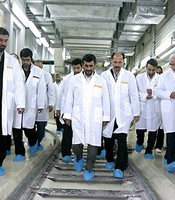The most alarming development cited in the International Atomic Energy Agency’s latest quarterly report (.pdf) on Iran’s nuclear program is that Tehran is preparing to double the number of high-intensity centrifuges in operation at its Fordow fuel enrichment plant from the current 700 to 1,400.
The situation at Fordow, which has been the focus of the past year’s international nuclear talks with Iran, has created a two-fold nuclear breakout problem. First, having learned how to increase the concentration of enriched uranium to 20 percent, Iran’s nuclear workers can more easily manufacture weapons-grade uranium, which involves further enriching the uranium to a fissile concentration of 90 percent. Second, Iran’s growing stock of 20 percent enriched uranium can be more easily converted to 90 percent highly enriched uranium (HEU) than its stockpiles enriched to the normal 3.5 percent level, which is used by commercial power reactors.
The IAEA report says that four new cascades of 174 centrifuges each have been tested under a vacuum to make sure they are airtight, the last step before they can begin enriching uranium hexafluoride gas. An additional 1,400 centrifuges have also been installed at Fordow, bringing the total to some 2,800, which is probably the maximum for which the facility was designed. Though inactive for now, these additional centrifuges could also be brought online in the coming months.

